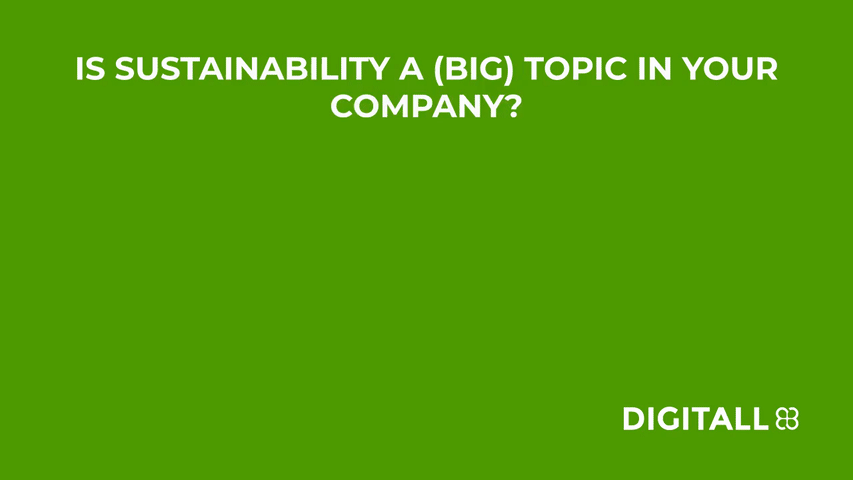2 min read
Why Customer Experience Is Becoming the Ultimate Competitive Edge
Products can be replaced, prices can be compared, but experiences last. In the chapter “Customer...
By Juliane Waack on 28.06.2023

8 min read
Climate change is a global concern and already influences markets, from disruptions due to natural disasters up to the many challenges that rising temperatures bring for many industries. Sustainability is therefore a crucial part not just of our economic future.
Content:

(Source: LinkedIn Survey via DIGITALL)
So, in what ways does sustainability affect economic trends and markets?
One of the most thriving and interesting sectors of today's economy are the development of alternative and renewable energy resources as well as the replacement of rare/critical materials that are often needed in manufacturing (e.g., for smartphones, which use many rare but also unsustainable materials).
Even the development and replacement of animal products with more sustainable alternatives (such as oat milk, lab-grown meat, etc.) can have a huge impact on different markets and our overall carbon footprint.
There are many different ways to generate energy, from solar and wind energy to heat pumps up to the use of excess warmth or even waste. However, we're still far away to fully rely on these renewable energy sources and are too dependent on oil and coal.
StartUS Insights has an interesting list of current startups that are currently working with ways to create and sustain energy smarter, for example with photovoltaic, hydro and compressed air technologies, surplus energy as well as bioenergy (via biofuels).
Rare minerals, unfortunately, are at the core of many of our modern manufacturing, from batteries to lasers and smartphones, we rely too much on these rare earth elements (REE) and will be forced to develop alternatives to avoid not only shortages but also the continued political dependence on the countries that provide REEs.
Rice University chemist James Tour explains in this short video, how REEs can also be extracted from waste which can additionally reduce harmful waste and even gain energy resources from it:
Currently, companies are looking into alternatives that have the same - or even better - results but use more common resources, such as iron-nitride magnets which are stronger than rare earth magnets and consist of iron and nitrogen.
Likewise, the Northeastern University's College of Engineering has patented a method of synthesizing tetraenite which is actually an even rarer resource only found in iron meteorites (read more about it here).
On the other hand, we've all heard of the science behind burgers that are designed in labs and are supposed to taste the same as a beef patty. Currently, production is still too expensive to be a valid replacement for meat but it is one of the many ways that animal-based products can be replaced or at least supplemented with other products whether artificial or from alternative natural sources.
The pandemic, the war in the Ukraine and the Suez canal debacle all had one thing in common: they showed how sensitive our supply chains are and how easily production, transport, and markets can be disrupted by unforeseen events.
While these events had an impact on how much companies are willing to "outsource" their production locations for the sake of cost savings, they also gave way to the opportunity for more sustainable supply chains based on location. A bio certified product can have a bigger carbon footprint, if it has been transported from another continent compared to a regular product that's been produced locally.
Sustainable supply chains have plenty of advantages, from more transparency to lower disruption risks up to potential cost savings due to fewer energy waste.
In his Ted Talk, Markus Mutz, CEO of OpenSC, explains how transparent supply chains can help the environment:
However, to attain this goal, it needs "inter- and multidisciplinary research (...) (engineering, natural science, business administration, OR ...) combining supply chain models with concepts like cycle assessment, industrial ecology, product design, (bio)chemical processes, etc." (source: EURO).
Whether it's the end of humanity as we know it or our salvation, artificial intelligence has so many different applications that it has a sheer endless possibility to support sustainability in almost every setting.
From smart buildings that can cool & heat according to their occupation as well as outside temperatures to smart factories that are able to calibrate machines to an optimum regarding output and energy consumption.
Since even small changes can have enormous results in bigger factories, from used resources to required energy, smart factories can make a big difference both for the financial and the environmental costs of production.
AI can also help creating so-called digital twins which are basically simulations that act like the real factory in a virtual space and can therefore be used for testing and gaining insights while the physical factory does not have to process any resources or energy for it.
Of course, to get to the point of a smart factory, it needs big amounts of data via data lakes or data warehouses which in turn need to be processed.
Mark Hahn, Senior Solutions Architect at Ericsson, explains why more data in this case is actually a good approach, since it can help a smart factory project to stay flexible:
By the way, cloud servers have their own sustainability topics which you can read about in our blog article.
Even if Elon Musk and some other CEOs who themselves rarely visit their offices think otherwise, remote work is here to stay and any attempt to force employees back to workplaces that can easily be digitalized, will only result in unnecessary costs, work dissatisfaction and increased staff fluctuation.

(Source: LinkedIn Survey via DIGITALL)
Since most remote workers stay at home and don't commute daily to their workplace, this automatically reduces the carbon footprint by creating less traffic (and less traffic jams). However, many companies have also used the new trend to reduce their office spaces and usage, which can help save water and electricity as well as rental costs.
Of course, for the construction and real estate industry, this does currently cause a bit of a crisis, but many other industries can save money and reduce their energy output and in turn even increase employee satisfaction, especially if they offer hybrid options in modern, flexible office environments and provide the appropriate equipment for remote work.
According to a report by Owl Labs and the Global Workplace Analytics, the switch to remote work during the pandemic reduced emissions by 25% during morning commutes and even 34% during evening commutes (via earth.org). Of course, these numbers are probably not as high anymore since many employees are back in their offices (whether on their own accord or due to management decisions) but these numbers show the drastic effect a move to more hybrid work options can (and will) have.
Our DIGITALL experts can help you set up the right platforms and systems to allow remote with collaboration tools, document sharing, and intuitive interfaces to not only digitize your processes and communication but also enable your employees.
Longevity is back in style. The last decades have shown a concerning increase in so-called "planned obsolescence" that result in people having to replace their household objects much faster since they break earlier but also are harder to repair. On top of that, trend cycles for fashion and technology have caused people to buy new versions of things just to be on top of the trends.
However, aside from certain legal questions that arise when it comes to technology that literally can't be repaired by its users as well as planned obsolescence critics, these developments have had a devastating impact on the environment causing massive amounts of waste each year that is impossible to recycle.
Circular economy aims to change these past "habits" of the economy by motivating recycling, reuse and sharing of resources and services to reduce waste and prevent the incessant need to produce new materials and products. You can read a lot more about circular economy here.
If more companies adopt this economic style, users will surely follow, since business models that make use of sharing, repairing and "upcycling" are already widely popular. However, political support is needed here to make sure that the control over the durability as well as level of repair-options are not in the hands of the companies but instead in the hands of the users.
Politics, companies and customers need to come together and align on measures to reduce needless waste by ensuring longevity of products, by offering ways to recycle or upcycle "old" products, and by allowing sharing before disposing materials and products. The more companies support these measurements and even create their own sustainable guidelines out of their own will, the better our chance to keep the planet a livable place.
You want to go digital to be more efficient, smarter, and leverage technology for more sustainability and flexibility? Our DIGITALL experts are happy to help you.
Juliane Waack is Editor in Chief at DIGITALL and writes about the digital transformation, megatrends and why a healthy culture is essential for a successful business.
by Sabine Kirchem
Products can be replaced, prices can be compared, but experiences last. In the chapter “Customer...
by Sabine Kirchem
Customer Relationship Management (CRM) is no longer just a technical discipline but revolves around...
by Sabine Kirchem
There's loads of data out there – but are we truly utilizing it? And more importantly, are we using...